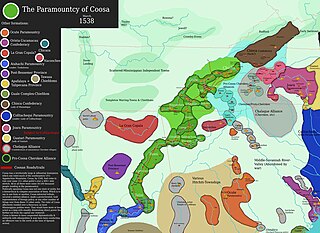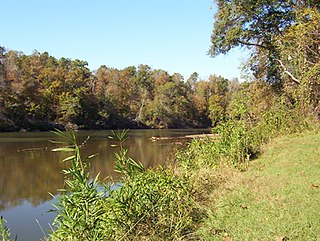Related Research Articles
Mobilian Jargon was a pidgin used as a lingua franca among Native American groups living along the Gulf of Mexico around the time of European settlement of the region. It was the main language among Native tribes in this area, mainly Louisiana. There is evidence indicating its existence as early as the late 17th to early 18th century. The Native groups that are said to have used it were the Alabama, Apalachee, Biloxi, Chacato, Pakana, Pascagoula, Taensa, Tunica, Caddo, Chickasaw, Houma, Choctaw, Chitimacha, Natchez, and Ofo. The name is thought to refer to the Mobile Indians of the central Gulf Coast, but did not originate from this group; Mobilian Jargon is linguistically and grammatically different from the language traditionally spoken by the Mobile Indians.

The Muscogee, also known as the Mvskoke, Muscogee Creek or just Creek, and the Muscogee Creek Confederacy, are a group of related Indigenous peoples of the Southeastern Woodlands in the United States. Their historical homelands are in what now comprises southern Tennessee, much of Alabama, western Georgia and parts of northern Florida.

Tallapoosa County is located in the east-central portion of the U.S. state of Alabama. As of the 2020 census, the population was 41,311. Its county seat is Dadeville. Its largest city is Alexander City.
Muscogee mythology is related to a Muscogee tribe who are originally from the southeastern United States, also known by their original name Mvskoke, the name they use to identify themselves today. Mvskoke is their name in traditional spelling. Modern Muscogees live primarily in Oklahoma, Alabama, Georgia, and Florida. Their language, Mvskoke, is a member of the Eastern branch of the Muskogean language family. The Seminole are close kin to the Mvskoke and speak an Eastern Muskogean language as well. The Muscogee were considered one of the Five Civilized Tribes. After the Creek War many of the Muscogee escaped to Florida to create the Seminole.

Scouting in Alabama has a long history, from the 1910s to the present day, serving thousands of youth in programs that suit the environment in which they live.

The term Five Civilized Tribes was applied by the United States government in the early federal period of the history of the United States to the five major Native American nations in the Southeast: the Cherokee, Chickasaw, Choctaw, Muscogee (Creek), and Seminoles. White Americans classified them as "civilized" because they had adopted attributes of the Anglo-American culture.

The Creek War, was a regional conflict between opposing Native American factions, European powers, and the United States during the early 19th century. The Creek War began as a conflict within the tribes of the Muscogee, but the United States quickly became involved. British traders and Spanish colonial officials in Florida supplied the Red Sticks with weapons and equipment due to their shared interest in preventing the expansion of the United States into regions under their control.

The Tombigbee River is a tributary of the Mobile River, approximately 200 mi (325 km) long, in the U.S. states of Mississippi and Alabama. Together with the Alabama, it merges to form the short Mobile River before the latter empties into Mobile Bay on the Gulf of Mexico. The Tombigbee watershed encompasses much of the rural coastal plain of western Alabama and northeastern Mississippi, flowing generally southward. The river provides one of the principal routes of commercial navigation in the southern United States, as it is navigable along much of its length through locks and connected in its upper reaches to the Tennessee River via the Tennessee-Tombigbee Waterway.

Etowah Indian Mounds (9BR1) are a 54-acre (220,000 m2) archaeological site in Bartow County, Georgia, south of Cartersville. Built and occupied in three phases, from 1000–1550 CE, the prehistoric site is located on the north shore of the Etowah River.

The Muscogee language, previously referred to by its exonym, Creek, is a Muskogean language spoken by Muscogee (Creek) and Seminole people, primarily in the US states of Oklahoma and Florida. Along with Mikasuki, when it is spoken by the Seminole, it is known as Seminole.

Muskogean is a Native American language family spoken in different areas of the Southeastern United States. Though the debate concerning their interrelationships is ongoing, the Muskogean languages are generally divided into two branches, Eastern Muskogean and Western Muskogean. Typologically, Muskogean languages are agglutinative. One documented language, Apalachee, is extinct and the remaining languages are critically endangered.

The Coosa chiefdom was a powerful Native American paramount chiefdom in what are now Gordon and Murray counties in Georgia, in the United States. It was inhabited from about 1400 until about 1600, and dominated several smaller chiefdoms. The total population of Coosa's area of influence, reaching into present-day Tennessee and Alabama, has been estimated at 50,000.

The Cherokee–American wars, also known as the Chickamauga Wars, were a series of raids, campaigns, ambushes, minor skirmishes, and several full-scale frontier battles in the Old Southwest from 1776 to 1794 between the Cherokee and American settlers on the frontier. Most of the events took place in the Upper South region. While the fighting stretched across the entire period, there were extended periods with little or no action.

The Cusabo were a group of American Indian tribes who lived along the coast of the Atlantic Ocean in what is now South Carolina, approximately between present-day Charleston and south to the Savannah River, at the time of European colonization. English colonists often referred to them as one of the Settlement Indians of South Carolina, tribes who "settled" among the colonists.

The Tallapoosas were a division of the Upper Creeks in the Muscogee Confederacy. Prior to Removal to Indian Territory, Tallapoosa lived along the Tallapoosa River in Alabama.
Hickory Ground, also known as Otciapofa is an historic Upper Muscogee Creek tribal town and an archaeological site in Elmore County, Alabama near Wetumpka. It is known as Oce Vpofa in the Muscogee language; the name derives from oche-ub,"hickory" and po-fau, "among". It is best known for serving as the last capital of the National Council of the Creek Nation, prior to the tribe being moved to the Indian Territory in the 1830s. It was added to the National Register of Historic Places on March 10, 1980.

Hillabee was an important Muscogee (Creek) town in east central Alabama before the Indian Removals of the 1830s.

Chinnabee, also spelled Chinneby or Chinnibee, is an unincorporated community in Talladega County, Alabama, United States.
References
Citations
- 1 2 3 4 5 6 7 8 9 10 11 12 13 14 William A. Read (1994). "Southeastern Indian Place Names in what is now Alabama" (PDF). Indian Place Names in Alabama. Alabama Department of Archives and History. Retrieved 8 April 2011.
- ↑ Hardy, Heather; Scancarelli, Janine (2005). Native Languages of the Southeastern United States. Lincoln, NE: University of Nebraska Press. pp. 69–71.
- ↑ Mithun, Marianne (1999). The Languages of Native North America. Cambridge: Cambridge University Press. ISBN 0-521-23228-7.
- ↑ "Alabama: The State Name". Alabama Department of Archives and History. Archived from the original on 2019-06-06. Retrieved 2007-02-24.
- ↑ Bright (2004), p. 29.
- ↑ Owen & Owen (1921), p. 77.
- ↑ Gannett (1902), p. 70.
- 1 2 Gannett (1902), p. 73.
- ↑ Bright (2004), p. 118.
- ↑ Bright (2004), p. 120.
- ↑ Bright (2004), p. 148.
- ↑ Bright (2004), p. 291.
- 1 2 Owen & Owen (1921), p. 1291.
- ↑ Hudson, Charles M. (1997). Knights of Spain, Warriors of the Sun . University of Georgia Press. pp. 230–232.
- ↑ U.S. Geological Survey Geographic Names Information System: Arbacoochee
- ↑ Bright (2004), p. 68-69.
- ↑ Bright (2004), p. 70.
- ↑ Owen & Owen (1921), p. 189.
- ↑ Read (1984), p. 15.
- ↑ Gannett (1902), p. 71.
- ↑ Bright (2004), p. 129.
- ↑ Read (1984), p. 31.
- ↑ Bright (2004), p. 149.
- ↑ Read (1984), p. 42.
- ↑ Owen & Owen (1921), p. 1066.
- ↑ Read (1984), p. 47.
- ↑ Bright (2004), p. 344.
- ↑ Bright (2004), p. 352.
- ↑ Bright (2004), p. 368.
- ↑ Foscue, Virginia (1989). Place Names in Alabama. Tuscaloosa: The University of Alabama Press. p. 112. ISBN 0-8173-0410-X.
- ↑ Bright (2004), p. 468.
- ↑ Bright (2004), p. 475.
- ↑ Bright (2004), p. 488.
- ↑ Read (1984), p. 67.
- ↑ Bright (2004), p. 525.
- ↑ Read (1984), p. 74.
- ↑ Bright (2004), p. 559.
- ↑ Read (1984), p. 77.
- ↑ Bright (2004), p. 74.
- ↑ U.S. Geological Survey Geographic Names Information System: Chattahoochee River
- ↑ Bright (2004), p. 90.
- ↑ Bright (2004), p. 257.
- ↑ Byington, Cyrus (1909). Choctaw Language Dictionary. Global Bible Society.
- ↑ U.S. Geological Survey Geographic Names Information System: Sea Warrior Creek
- ↑ Bright (2004), p. 431.
- ↑ Bright (2004), p. 463.
- ↑ Rufus Ward (February 27, 2010). "Tombigbee River: What does it mean?". The Commercial Dispatch. The Columbus Lowndes Public Library. Retrieved 8 April 2011.
- ↑ Bright (2004), p. 558.
Sources
- Bright, William (2004). Native American Placenames of the United States. Norman: University of Oklahoma Press. ISBN 080613576X.
- Gannett, Henry (1902). The origin of certain place names in the United States, Volume 8, Issue 197. Washington, D.C.: Government Printing Office. p. 70. Retrieved April 8, 2011.
- Gannett, Henry (1905). The Origin of Certain Place Names in the United States. U.S. Government Printing Office. p. 27. Archived from the original on 2020-08-10. Retrieved 2018-08-09.
- Owen, Thomas McAdory; Owen, Marie Bankhead (1921). History of Alabama and dictionary of Alabama biography, Volume 1. Chicago: S. J. Clarke Publishing Company.
- Read, William A. (1984). Indian Place Names in Alabama. Tuscaloosa: The University of Alabama Press. p. 15. ISBN 0-8173-0231-X.